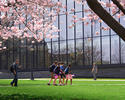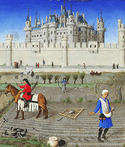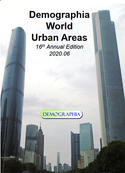The years to come seem likely to see America’s historic population dispersion continue or accelerate, as pandemic and lockdown worries have severely reduced the attractiveness of dense urban cores (especially in the highest density areas, such as New York City). As a result, the sparsely populated outer areas of combined statistical areas (CSAs), the largest category of local labor market defined by the Office of Management and Budget (OMB), could be the destination of many former urban core households. read more »
Demographics
Combined Statistical Areas: Ready for the Dispersion Demand
- Login to post comments
Networks and Cities in a Post-COVID Era
Not long ago, Tom Delonge, one of the founders of the punk-rock band Blink 182 and founder/front man for the alternative band Angels and Airwaves, decided to put together an interesting public benefit corporation based in California. It just so happens to be a company that conducts research on UFOs. But what’s interesting here is how Delonge’s To The Stars Academy (TTSA) have been able to promote this subject, not just on obscure websites or the Joe Rogan podcast, but through other more surprising channels. read more »
- Login to post comments
Perspective: U. S. COVID-19 Deaths and Urban Population Density
There is wide consensus that the COVID-19 virus spreads person-to-person, especially in confined spaces that are insufficiently ventilated. It is exacerbated by prolonged proximity, which John Brooks, the Centers for Disease Control and Prevention’s chief medical officer indicates is 15 minutes or more of unprotected contact with someone less than 6 feet away. read more »
- Login to post comments
No, College Kids Aren't All Reckless or Selfish
There’s no denying that the new spike in COVID-19 cases we are seeing is driven by “younger Americans.” Some states are re-closing bars and restaurants, or pausing other reopening measures. Dr. Anthony Fauci might have put it best when he told a Senate committee, “Bars: really not good, really not good.” But people are seeing the word “younger” and misreading it as “college kids.” read more »
- Login to post comments
Storied Cities
Athens is the birthplace of Western culture, with the physical ruins of its classical age still visibly present as a perpetual reminder. Virgil composed his epic poem, The Aeneid, recounting the mythic flight of Aeneas from defeated Troy to Italy, becoming the forbear of Rome. New York sees itself as unique center of commerce, founded when the Dutch (not the English) bought Manhattan for beads in the city’s first hustle. Nashville needs no reminder that it’s the center of country music, nor Detroit that it is the Motor City. read more »
- Login to post comments
How the Virus Is Pushing America Toward a Better Future
Pessimism is the mood of the day, with 80 percent of Americans saying the country is generally out of control. Even before civil unrest and pestilence, most Americans believed our country was in decline, Pew reported, with a shrinking middle class, increased indebtedness and growing polarization. read more »
State of the Nation on July 4 and How It Has Changed Over Time
Coronavirus, a shattered economy, racial tensions, deep partisan polarization. Is it any surprise that Americans are down in the dumps? How could it be otherwise? Putting today’s sentiments in historical perspective using polls conducted over many years helps to assess our current malaise. read more »
- Login to post comments
Triumph of the Oligarchs
A new class of overlords are making their bid for world domination.
The Coronavirus has trammeled the prospects of most Americans, particularly low-income workers. But for one small group, the pandemic has proved something like manna from heaven. Already ascendant beforehand, the tech oligarchy—a relatively small number of companies, venture, and private equity funds—are riding the current crisis to unprecedented dominion over our ever-weakening Republic. read more »
- Login to post comments
Demographia World Urban Areas, 2020: Tokyo Lead Diminishing
For the first time in more than six decades the world’s second ranked built-up urban area has reached within 10% of leader Tokyo. The 2020 edition of Demographia World Urban Areas reports that Jakarta has reached a population of 34.5 million, behind Tokyo-Yokohama’s 38.0 million (Figure 1). The report can be downloaded here (Note 1). read more »
- Login to post comments
Feudalism and Stagnation in South Africa
As I am writing this article, South Africa is predicted, following the coronavirus crises, to have an unemployment rate of 50% i.e. 1 in 2 working adults .The country’s lockdown has now been longer than the one in authoritarian China and to make matters worse, South Africa’s credit rating has been recently downgraded by agencies such as Fitch, Standard and Poor, and Moody’s. read more »
- Login to post comments






















